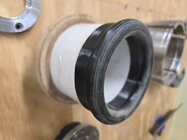Looking for recommendations for sturdy non-marring gasket material for shop-made vacuum chucks.
Last edited:

Love my Rubberchucky seals.Have them on all of my vacuum chucksthese are worth taking a look at.

Chucky PVC Coupling Vacuum Seals
Rubber Chucky Products, LLC manufacturers and distributes rubber jam chucks and other woodturning aids; enabling both the beginning and professional woodturner an easier way to create their masterpieces. Proudly made in the USAwww.rubberchucky.com


I have had the same issue of the Rubber Chucky seals getting hard and not holding as well. I too have had to use a ring of craft foam so they chucks hold enough vacuum to hold.I've had Rubber Chucky seals (the ones that go on PVC adapters) for several years. I liked them at first, but they've gotten hard and I have to use a ring of craft foam on top to help them seal and keep from marking.
I asked the guy at their booth at Rocky Mountain symposium about it but he didn't know anything.
Paul, I checked Printables for your stl’s of these and didn’t find anything. Are you sharing these models?I've converted a few people in my club to these. They are 3d printed out of flexible filament (TPU) and have tunable "squish" based on how much infill you include when printing. They are rigid enough to be used strictly as a jam chuck, but also seal a very nice vacuum. No marring at all and they just slide right over. My model is also parametric, so to get different size you just input a new diameter.
View attachment 69807
That’s what the skewi is foWith the fun foam I cut the diameters with my laser. If you have a laser it is easy to make up several at a time.
I’m not sure how I would use a skew to cut the circles. I use adhesive backed fun foam. Using the laser I cut the inner diameter and outer diameter, peel off the backing and apply.That’s what the skewi is fo
It is one of those I just haven't gotten around to uploading. I'll try to do that in the next day or so.Paul, I checked Printables for your stl’s of these and didn’t find anything. Are you sharing these models?
Thanks, Tom
Go to hobby lobby and buy a pack of adhesive backed closed cell foam. About 25 multi -colored 8-1/2 x 11 sheets for I believe $5 to $9 bucks a pack. Works greatLooking for recommendations for sturdy non-marring gasket material for shop-made vacuum chucks.
I’m not sure how you would eitherI’m not sure how I would use a skew to cut the circles. I use adhesive backed fun foam. Using the laser I cut the inner diameter and outer diameter, peel off the backing and apply.
I don't use a skew, but similarly I use a utility knife blade (preferred for stiffness) or an Xacto knife. Adhere the foam to the chuck ... turn on lathe (slow speed) ... put blade on the tool rest ... push tip of blade into foam (be sure to be on center) ... voila!I’m not sure how I would use a skew to cut the circles. I use adhesive backed fun foam. Using the laser I cut the inner diameter and outer diameter, peel off the backing and apply.
but similarly I use a utility knife blade (preferred for stiffness) or an Xacto knife.
Here you go:Paul, I checked Printables for your stl’s of these and didn’t find anything. Are you sharing these models?
Thanks, Tom
